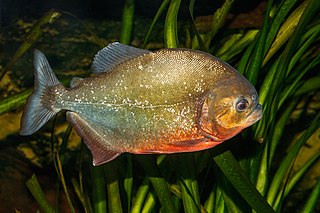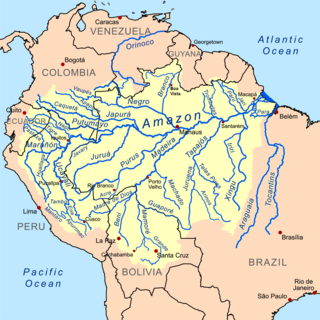
Catfish are a diverse group of ray-finned fish. Named for their prominent barbels, which resemble a cat's whiskers, catfish range in size and behavior from the three largest species alive, the Mekong giant catfish from Southeast Asia, the wels catfish of Eurasia, and the piraíba of South America, to detritivores, and even to a tiny parasitic species commonly called the candiru, Vandellia cirrhosa. Neither the armour-plated types nor the naked types have scales. Despite their name, not all catfish have prominent barbels or "whiskers". Members of the Siluriformes order are defined by features of the skull and swimbladder. Catfish are of considerable commercial importance; many of the larger species are farmed or fished for food. Many of the smaller species, particularly the genus Corydoras, are important in the aquarium hobby. Many catfish are nocturnal, but others are crepuscular or diurnal.

The white perch is not a true perch but is a fish of the temperate bass family, Moronidae, notable as a food and game fish in eastern North America. In some places it is referred to as "Silver Bass".

The muskellunge, often shortened to muskie,musky, ski, or lunge, is a species of large freshwater predatory fish native to North America. It is the largest member of the pike family, Esocidae.

Herring are various species of forage fish, mostly belonging to the family Clupeidae.

The term carp is a generic common name for numerous species of freshwater fish from the family Cyprinidae, a very large clade of ray-finned fish mostly native to Eurasia. While carp are prized quarries and are valued as both food and ornamental fish in many parts of the Old World, they are considered trash fish and invasive pests in many parts of Africa, Australia and most of the United States.

Balitoridae, the hillstream loaches or river loaches, is a family, of small fish from South, Southeast and East Asia. The family includes about 202 species. They are sometimes sold as "lizardfish" or "flossensaugers". Many of the species are popular for aquaria, species in the genus Sewellia are most commonly sold in the aquaria trade. They have a number of similarities with the Cobitidae, their sibling family of "loaches", such as multiple barbels around the mouth. They should not be confused with the loricariids, which look similar but are a family of catfish.

Sardine and pilchard are common names for various species of small, oily forage fish in the herring suborder Clupeoidei. The term 'sardine' was first used in English during the early 15th century; a somewhat dubious etymology says it comes from the Italian island of Sardinia, around which sardines were once supposedly abundant.

A piranha or piraña is any of a number of freshwater fish species in the family Serrasalmidae, or the subfamily Serrasalminae within the tetra family, Characidae in order Characiformes. These fish inhabit South American rivers, floodplains, lakes and reservoirs. Although often described as extremely predatory and mainly feeding on fish, their dietary habits vary extensively, and they will also take plant material, leading to their classification as omnivorous.

The Amazon basin is the part of South America drained by the Amazon River and its tributaries. The Amazon drainage basin covers an area of about 7,000,000 km2 (2,700,000 sq mi), or about 35.5 percent of the South American continent. It is located in the countries of Bolivia, Brazil, Colombia, Ecuador, Guyana, Peru, Suriname, and Venezuela, as well as the territory of French Guiana.

The chum salmon, also known as dog salmon or keta salmon, is a species of anadromous salmonid fish from the genus Oncorhynchus native to the coastal rivers of the North Pacific and the Beringian Arctic, and is often marketed under the trade name silverbrite salmon in North America. The English name "chum salmon" comes from the Chinook Jargon term tsəm, meaning "spotted" or "marked"; while keta in the scientific name comes from Russian, which in turn comes from the Evenki language of Eastern Siberia. The term 'Dog Salmon' is most commonly used in Alaska and refers to the Salmon whose flesh Alaskans use to feed their dogs.
George Sprague Myers was an American ichthyologist who spent most of his career at Stanford University. He served as the editor of Stanford Ichthyological Bulletin as well as president of the American Society of Ichthyologists and Herpetologists. Myers was also head of the Division of Fishes at the United States National Museum, and held a position as an ichthyologist for the United States Fish and Wildlife Service. He was also an advisor in fisheries and ichthyology to the Brazilian Government.
Pseudoplacocheilus is a monospecific genus of freshwater ray-finned fish belonging to the family Cyprinidae, the family which includes the carps, barbs. minnows and related species. The only species in the genus is Pseudoplacocheilus cryptonemus which is endemic to Yunnan where it occurs in the upper Salween River and the upper Mekong River basins. It is found in clear waters and uses crevices in rocks to hide in.

Bangana is a genus of fish in the family Cyprinidae, the carps and minnows. It is distributed across much of southern and eastern Asia. Species live mainly in the flowing waters of tropical and subtropical rivers.
Pseudocrossocheilus is a genus of cyprinid fish endemic to China. There are currently five recognized species in this genus.
Pseudocrossocheilus bamaensis is a species of freshwater ray-finned fish belonging to the family Cyprinidae, the family which includes the carps, barbs, minnows and related fishes. This fish is endemic to China where it occurs in the Hongshui River, as well as its tributary the Beipanjiang River, in Guangxi and Guizhou. Here it is found in crevices and caves in rocks emerging in the morinings and evenings to feed in the Spring and Summer, remaining in its rock shleters during the winter. This fish has a maximum published total length of 21.5 cm (8.5 in)>
Pseudocrossocheilus liuchengensis, the oil fish, is a species of freshwater ray-finned fish belonging to the family Cyprinidae, the family which includes the carps, barbs, minnows and related fishes. This species is endemic to Guangxi where it lives only in subterranean rivers.
Pseudocrossocheilus nigrovittatus is a species of freshwater ray-finned fish belonging to the family Cyprinidae, the family which includes the carps, barbs, minnows and related fishes. This species is found in fast flowing rivers in the middle Pearl River basin in Guizhou.
Pseudocrossocheilus papillolabrus is a species of freshwater ray-finned fish belonging to the family Cyprinidae. This species is found in rivers and fast flowing mountain streams in Guizhou.
Pseudocrossocheilus tridentis is a species of freshwater ray-finned fish belonging to the family Cyprinidae, the family which includes the carps, barbs, minnows and related fishes. This fish has a wide distribution in the middle and lower Nanpan River in Yunnan and Guizhou. P. tridentis is found in the lower layers of fast-flowing rivers or montane streams>











